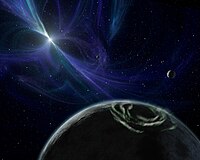
Photo from wikipedia
Assuming all binary Neutron Star mergers produce Short Gamma Ray Bursts (SGRBs), we combine the merger rates of binary Neutron Stars (BNS) from population synthesis studies, the sensitivities of advanced… Click to show full abstract
Assuming all binary Neutron Star mergers produce Short Gamma Ray Bursts (SGRBs), we combine the merger rates of binary Neutron Stars (BNS) from population synthesis studies, the sensitivities of advanced Gravitational Wave (GW) interferometer networks, and of the electromagnetic (EM) facilities in various wave bands, to compute the detection rate of associated afterglows in these bands. Using the inclination angle measured from GWs as a proxy for the viewing angle and assuming a uniform distribution of jet opening angle between 3 to 30 degrees, we generate light curves of the counterparts using the open access afterglow hydrodynamics package BoxFit for X-ray, Optical and Radio bands. For different EM detectors we obtain the fraction of EM counterparts detectable in these three bands by imposing appropriate detection thresholds. In association with BNS mergers detected by five (three) detector network of advanced GW interferometers, assuming a BNS merger rate of $0.6-774{\rm Gpc}^{-3}{\rm yr}^{-1}$~\citep{dominik2012double}, we find the afterglow detection rates (per year) to be $0.04-53$ ($0.02-27$), $0.03-36$ ($0.01-19$) and $0.04-47$ ($0.02-25$) in the X-ray, optical and radio bands respectively. Our rates represent maximum possible detections for the given BNS rate since we ignore effects of cadence and field of view in EM follow up observations.
Journal Title: Monthly Notices of the Royal Astronomical Society
Year Published: 2018
Link to full text (if available)
Share on Social Media: Sign Up to like & get
recommendations!